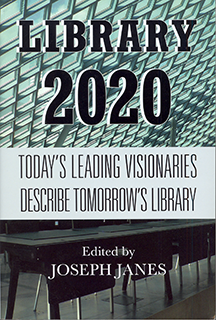Library 2020
 Library 2020: Today’s Leading Visionaries Describe Tomorrow’s Library edited by Joseph Janes, The Scarecrow Press Inc., 2013. 161 pages.
Library 2020: Today’s Leading Visionaries Describe Tomorrow’s Library edited by Joseph Janes, The Scarecrow Press Inc., 2013. 161 pages.
What will the libraries of the year 2020 be like? Will the work of librarians be much different? What types of services will library patrons expect from their libraries? These are the types of questions tackled in this book, edited by Joseph Janes, on faculty with the MLIS program at the University of Washington Information School where he is associate professor and chair. Janes compiles his own opinions and forecasts alongside 23 other library experts who have a variety of backgrounds, including those who work in academic libraries, public libraries, nonprofit organizations, and private companies.
This book focuses specifically on academic and public libraries. In compiling this book, Janes divides it into four general categorie — “Stuff,” which focuses on services libraries will offer, “People,” discussing what will be expected of librarians and what types of interactions and influences will occur between librarians and their patrons, “Community,” which covers how librarians and the communities they serve will impact each other, “Place,” which talks about the architecture and interior design changes libraries will go through, and “Leadership and Vision,” discussing the type of mentality librarians will take on in order to survive and thrive in their environments. Since all of these general categories tend to overlap and affect one another in the library world, it’s no surprise the writers who cover one category often end up mentioning things that fall in another category.
Several writers predict libraries will do away with print books altogether (except children’s books) as well as digital resources tied to physical formats, such as CDs and DVDs. There are also other predictions mentioned several times which seem to point to librarians as being curators of the digital world and digitization of resources. The role of libraries as community-oriented makerspace–to provide the tools and means for people to come together to share ideas and teach one another how to make things–is also a common theme.
One of the more unique forecasts is the idea that most concerns about copyright will be resolved pertaining to digital rights management (DRM), pay walls, and licensing rules and regulations for access to ebooks or other digital resources to bring about economic success for all parties involved. At least three basic things become clear when one finishes reading the book: (1) Libraries will still face budget challenges, forcing them to continue being frugal; (2) Libraries will require staff flexibility to keep up with the technological changes that affect the way patrons search for and acquire what they seek; and (3) Libraries will still need librarians to connect people with the best sources and resources for their needs and wants. Some of these forecasts may come true while others may not, but this book serves as an interesting gauge for what leaders in librarianship are thinking about as libraries move forward.
– Reviewed by Harry Gaylord
